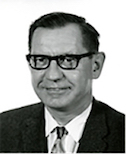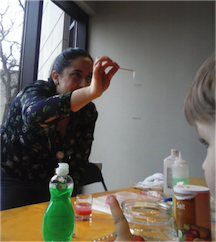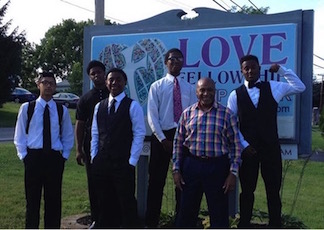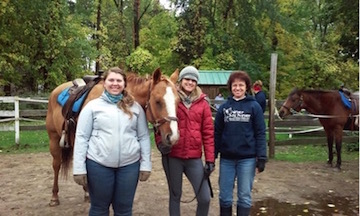The Spirit of Service in Trainee Scientists at the University of Rochester
News Article by Claire McCarthy, PhD Candidate
 Along with a history of advances in biomedical research, scientists at UR have established a legacy of outreach and service. Dr. William F. Neuman was a founder and Chair of the Department of Radiation Biology and Biophysics at UR, which stemmed from his work with the Manhattan Project. He was a world-renowned expert in the musculoskeletal field who made significant contributions into the understanding of bone matrix physiology and hormonal effects on bone structure. However, in addition to his work in orthopedics, Dr. Neuman believed that scientists should serve their communities and be “good people.”
Along with a history of advances in biomedical research, scientists at UR have established a legacy of outreach and service. Dr. William F. Neuman was a founder and Chair of the Department of Radiation Biology and Biophysics at UR, which stemmed from his work with the Manhattan Project. He was a world-renowned expert in the musculoskeletal field who made significant contributions into the understanding of bone matrix physiology and hormonal effects on bone structure. However, in addition to his work in orthopedics, Dr. Neuman believed that scientists should serve their communities and be “good people.”
As a “citizen scientist,” Dr. Neuman often used the skills and knowledge he gained as a researcher to contribute in multiple ways to the community. Globally, based on his work with radiation, he became an active member in SANE (the Committee for SANE Nuclear Policy), which promoted disarmament and the dissemination of information about the dangers related to the arms race. He believed that scientists needed to share the risks about nuclear weapons. Locally, according to his daughter, Carol Neuman Tomson, Dr. Neuman used managerial skills that he gained from his administrative work at UR to assist with the relocation of the First Unitarian Church of Rochester. He played a major role “in getting the world-famous architect Louis Kahn to build the new church.” Dr. Neuman was also interested in outreach. He tried to get local kids interested in science by performing as a “Mad Scientist” at grade schools and Boy Scout gatherings. Carol Neuman Tomson said, “He wore his white lab coat and a crazy Einstein-like wig and acted like a clown...he managed to make potions in a test tube explode and electrodes arc.” His goal was to show children that science could be fun. Through his actions and service, Dr. Neuman taught us that scientists should volunteer and work to benefit society.
Today, many biomedical graduate students at the UR follow in Dr. Neuman’s footsteps to be “good people” through their volunteer work. Despite hectic schedules -- experiments, course work, writing manuscripts and grants, reading scientific articles, and more --graduate students make time to reach out to members of the community. They give their time, skills, and enthusiasm to help others living in Rochester.
 Liz Albertorio-Saez, who recently got her MS in Microbiology and Immunology at UR performs service work at the Rochester Museum and Science Center (RMSC). When she was a graduate student, she investigated volunteer opportunities at RMSC and helped out with the “Ask It” program, where she engaged museum visitors with science exhibits. Later, Liz created a series of workshops to help other UR graduate students understand the concept of informal learning and to prepare hands-on scientific demonstrations with RMSC visitors. She continues to educate the public about science as the RMSC Volunteer Coordinator and helps teach scientists effective communication skills through her work with the museum. Liz said, “By volunteering, I have become more connected to the local community and (this) has made me think about how to engage in science outreach with a societal purpose.”
Liz Albertorio-Saez, who recently got her MS in Microbiology and Immunology at UR performs service work at the Rochester Museum and Science Center (RMSC). When she was a graduate student, she investigated volunteer opportunities at RMSC and helped out with the “Ask It” program, where she engaged museum visitors with science exhibits. Later, Liz created a series of workshops to help other UR graduate students understand the concept of informal learning and to prepare hands-on scientific demonstrations with RMSC visitors. She continues to educate the public about science as the RMSC Volunteer Coordinator and helps teach scientists effective communication skills through her work with the museum. Liz said, “By volunteering, I have become more connected to the local community and (this) has made me think about how to engage in science outreach with a societal purpose.”
 In addition to science outreach, E’Lissa Flores, a PhD graduate student in Translational Biomedical Sciences, volunteers every Friday as a tutor for a couple of 6th grade students. She is part of a group of UR medical and graduate students that work with k-12th graders at Love Fellowship Worship Center. The tutoring group helps students in subject areas where they are struggling, as well as assist with homework and SAT prep. For example, E’Lissa made academic and classroom goals with her students for the upcoming spring semester in December. After winter break, “The first week back to school, one of my students received the honor of being ‘Student of the Week.’ She was excited to share the news with me and show off her certificate. It was a truly, proud moment.” Tutoring allows E’Lissa to strengthen important skills for a career in academic science research, including teaching experience, mentoring skills, and communication with many different age groups.
In addition to science outreach, E’Lissa Flores, a PhD graduate student in Translational Biomedical Sciences, volunteers every Friday as a tutor for a couple of 6th grade students. She is part of a group of UR medical and graduate students that work with k-12th graders at Love Fellowship Worship Center. The tutoring group helps students in subject areas where they are struggling, as well as assist with homework and SAT prep. For example, E’Lissa made academic and classroom goals with her students for the upcoming spring semester in December. After winter break, “The first week back to school, one of my students received the honor of being ‘Student of the Week.’ She was excited to share the news with me and show off her certificate. It was a truly, proud moment.” Tutoring allows E’Lissa to strengthen important skills for a career in academic science research, including teaching experience, mentoring skills, and communication with many different age groups.
 Along with education, Jessica Meyers, a Toxicology PhD graduate student, volunteers at Never Say Never Stables in Webster. According to Jess, “the organization gives horseback riding lessons to children and teens who are coping with physical, mental, or emotional challenges.” She helps the children there ride, pet, and groom the horses, as well as assists with the care of the horses. Kids at the stables get excited about riding horses and come out of their shells, gaining confidence that helps them in other aspects of their lives. Jess said that focusing on the kids and horses on Saturdays, “fills me with a sense of gratitude and happiness, that overall, makes me a better scientist when I come back to the lab.”
Along with education, Jessica Meyers, a Toxicology PhD graduate student, volunteers at Never Say Never Stables in Webster. According to Jess, “the organization gives horseback riding lessons to children and teens who are coping with physical, mental, or emotional challenges.” She helps the children there ride, pet, and groom the horses, as well as assists with the care of the horses. Kids at the stables get excited about riding horses and come out of their shells, gaining confidence that helps them in other aspects of their lives. Jess said that focusing on the kids and horses on Saturdays, “fills me with a sense of gratitude and happiness, that overall, makes me a better scientist when I come back to the lab.”
There are many other volunteer stories that trainees at UR could share, as well as multiple resources to help people find community service opportunities. Student organizations at UR often send out advertisements for volunteers in emails and newsletters, such as opportunities to help high school students learn about biology with the Life Sciences Learning Center and events with medical students (including Free Youth Physicals, Tutoring, and a “Vagina Monologues” performance to raise money for Planned Parenthood). Additionally, Katrina Korfmacher, the director of the Community Outreach and Engagement Core of Environmental Health Sciences, can help students interested in science outreach. Graduate students can also find local volunteer options at volunteermatch.com and the upcoming events page of the Democrat and Chronicle. Many UR trainees carry on a legacy of service by finding ways to get involved with the community and follow in the footsteps of renowned UR researchers like Dr. William F. Neuman.
Acknowledgement
I would like to thank Brett Tomson for helping me learn more about Dr. William Neuman’s work as a citizen scientist and for sharing historical materials (newspaper articles and a document by Carol Neuman Tomson) about Dr. Neuman with me.
Tracey Baas |
4/6/2017
You may also like